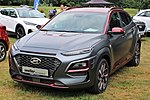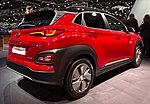Hyundai Kona
| Hyundai | |
|---|---|
| Kona | |
| Production period: | since 2017 |
| Class : | SUV |
| Body versions : | Station wagon |
| Engines: |
Otto engines : 1.0–1.6 liters (88–130 kW) Diesel engine : 1.6 liters (85–100 kW) Otto hybrid : 1.6 liters (104 kW) Electric motor : (100–150 kW) |
| Length: | 4165-4180 mm |
| Width: | 1800 mm |
| Height: | 1550-1570 mm |
| Wheelbase : | 2600 mm |
| Empty weight : | 1233-1818 kg |
| Stars in the Euro NCAP - Crash Test (2017) |
|
The Hyundai Kona is a Sport Utility Vehicle (SUV) from the South Korean car manufacturer Hyundai and at the same time the smallest SUV in the product range. The designer of the vehicle is Luc Donckerwolke .
history
The Kona was presented in June 2017, the market launch took place in early November 2017 with two gasoline engines . A newly developed diesel engine in two power levels and a variant with electric drive followed in 2018 . In June 2019, Hyundai introduced the Kona with hybrid drive .
In December 2018, Hyundai presented the special model Iron Man Edition . In addition to extensive equipment, it offers some details that relate to Marvel Comics' superhero figure Iron Man .
In July 2020, Hyundai presented the special Night Edition model for the North American market . It is characterized by a dark color.
Kona electro
On February 27, 2018, Hyundai introduced the Kona Elektro . The Elektro has two motor power variants and two battery sizes with ranges of 289 km and 449 km according to WLTP . Both ranges had to be corrected downwards in December 2018 after incorrect measurement results. It is largely identical to the Kona, which was introduced in 2017, but like the Ioniq Elektro, the front of the vehicle is closed except for the charging socket in this area. Summer 2018 was announced for the market launch. The Kona Elektro also has liquid thermal management, which means that, for example, the battery does not heat up when charging and the charging power would therefore have to decrease.
Hyundai Kona Electric, Geneva Motor Show 2018
The Kona Elektro with the 39.2 kWh battery and 100 kW (136 PS) engine output (range 289 km) will only be available in the Trend (including automatic air conditioning, heated seats and navigation system) and Style (including heat pump) . With the 64 kWh battery and 150 kW (204 PS) engine output (range 449 km) also in the premium equipment. Hyundai grants an 8-year unlimited mileage guarantee on the vehicle (five-year manufacturer's guarantee, then a three-year follow-up guarantee from an insurance company. Three years for car audio including navigation or multimedia and for type 2 charging cables) and 8 years or 160,000 km on the battery Mileage, whichever comes first.
In March 2020, production of the Elektro in the Czech Hyundai plant in Nošovice started, tripling production capacity, 30,000 vehicles are manufactured in this plant per year.
Also in spring 2020, the configuration of the Kona was changed slightly, adjustments to the chassis and low-friction tires reduced the rolling resistance. Consumption was reduced from 15.4 kWh to 14.7 kWh, increasing the range by 8% to 484 km.
During a hypermiling attempt on the Lausitzring with 3 Kona electric as standard equipment, the air conditioning and the entertainment system were switched off, the daytime running remained switched on as in normal road conditions. The maximum range was 1,026 km with an average speed of 29–30 km / h. This is a speed that corresponds to normal city traffic. The test drivers were provided by auto bild , technicians from Hyundai Germany and product management and the press office of Hyundai Germany. The results were confirmed by the operator of the Lausitzring Dekra .
Load capacity
The charging time for a quick charge from 0 to 80% requires the model with 39.2 kWh at a 50 kW charging station 57 minutes, the model with 64 kWh requires 75 minutes. Both models need 54 minutes at a charging station with at least 70 kW.
Kona hybrid
The Kona Hybrid , presented in June 2019, is powered by a 1.6-liter gasoline engine with 77 kW (105 PS) and an electric motor with 32 kW (44 PS). The system output of the drive is 104 kW (141 hp). The lithium-ion polymer accumulator has a capacity of 1.56 kWh. In the Hyundai Motor Group , this drive train is already used in the Kia Niro and the Hyundai Ioniq Hybrid .
background
The name of the SUV is derived from a region in Hawaii . In Portugal , the Kona is named Kauai because the Portuguese word cona means " vulva " in the vulgar language . In China , the vehicle has been sold as Hyundai Encino since April 2018 .
Also in June 2017, sister company Kia Motors presented the Stonic, a compact SUV. However, this is based on a different platform and is also available with weaker engines and only with front-wheel drive .
Technical specifications
| 1.0 T - GDI | 1.6 T-GDI | 1.6 CRDi | Hybrid | Electric | |||||
|---|---|---|---|---|---|---|---|---|---|
| Construction period | 11/2017–06/2018 | since 06/2018 | 11/2017–06/2018 | since 06/2018 | since 05/2018 | since 08/2019 | since 02/2018 | ||
| Engine characteristics | |||||||||
| Engine type | R3 petrol engine | R4 petrol engine | R4 diesel engine | R4 petrol engine + electric motor | Permanent magnet synchronous electric motor | ||||
| Engine charging | turbocharger | - | |||||||
| Displacement | 998 cc | 1591 cc | 1598 cc | 1580 cc | - | ||||
| Max. Power at min −1 | 88 kW (120 PS) / 6200 | 88 kW (120 PS) / 6000 | 130 kW (177 PS) / 5500 | 85 kW (115 PS) / 4000 | 100 kW (136 PS) / 4000 | 104 kW (141 hp) / 5700 (1) | 100 kW (136 hp) | 150 kW (204 hp) | |
| Max. Torque in min -1 | 172 Nm / 1500-4000 | 265 Nm / 1500-4500 | 320 Nm / 1750-2250 | 265 Nm / 4000 (2) | 395 Nm | ||||
| Power transmission | |||||||||
| Drive, as standard | Front wheel drive | all wheel drive | Front wheel drive | ||||||
| Drive, optional | - | (All wheel drive) | - | (All wheel drive) | - | ||||
| Gearbox, as standard | 6-speed manual transmission | 7-speed double clutch transmission | 6-speed manual transmission | 7-speed dual clutch transmission | 6-speed dual clutch transmission | 1-stage reduction gear | |||
| Readings | |||||||||
| Top speed | 181 km / h | 205 km / h | 210 km / h (205 km / h) |
183 km / h | 191 km / h (186 km / h) |
160 km / h | 155 km / h | 167 km / h | |
| Acceleration, 0-100 km / h | 12.0 s | 7.9 s | 7.7 s (7.9 s) |
10.7 s | 10.2 s (11.2 s) |
11.6 s | 9.9 s | 7.9 s | |
| Fuel / energy consumption over 100 km (combined) |
5.2–5.4 l super | 5.7 l super | 6.7 l super | 6.3 l super (7.7 l super) |
4.3 l diesel | 4.5 l diesel (4.9 l diesel) |
4.3 l super | 14.3 kWh | 14.7 kWh |
| CO 2 emissions, combined | 117-125 g / km | 129 g / km | 153 g / km | 144 g / km (160 g / km) |
113 g / km | 115 g / km (127 g / km) |
99 g / km | - | |
| Battery capacity | - | 1.56 kWh | 39.2 kWh | 64 kWh | |||||
| Battery type | - | Lithium ion polymer | |||||||
| electrical range according to WLTP | - | ? | 305 km WLTP | 484 km WLTP415 km EPA | |||||
| Emission standard | Euro 6 | Euro 6d-TEMP | Euro 6 | Euro 6d-TEMP | - | ||||
Registration numbers
In the first year of sales 2017, 1,141 Hyundai Kona were newly registered in the Federal Republic of Germany - 5 of them with diesel drive and 340 with all-wheel drive. In 2018 there were 13,026 vehicles - including 26 with diesel drive, 381 with electric drive and 4,430 with all-wheel drive. In 2019, of the total of 22,107 newly registered Kona 941s had a diesel drive, 890 a hybrid drive, 3,521 an electric drive and 2,810 all-wheel drive.
Web links
Individual evidence
- ↑ a b c d e Peter R. Fischer, Dirk Branke: All information about the Hyundai Kona. autobild.de, June 15, 2017, accessed on June 23, 2017 .
- ↑ Electric Kona has a range of 470 km
- ↑ a b 2018 Hyundai Kona Unveiled; Smaller Than Creta. In: Motoringjunction.com. June 17, 2017, accessed June 23, 2017 .
- ↑ Result of the Hyundai Kona in the Euro NCAP crash test (2017)
- ^ New Kona. In: Hyundai.co.uk. Hyundai Motor UK, accessed June 23, 2017 .
- ↑ Kona Electric SUV From Hyundai May Have 210 Mile Range [Hot! - CleanTechnica] . Retrieved October 13, 2017.
- ↑ Hyundai Kona EV with 240 mile electric range will debut at the 2018 Geneva Motor Show - Cars UK . September 25, 2017. Retrieved October 13, 2017.
- ↑ Hyunda homepage of Kona Electric
- ↑ a b Martin Franz: New: Hyundai Kona Hybrid. In: heise.de. June 6, 2019, accessed June 7, 2019 .
- ↑ Hyundai Kona Iron Man: The Little Comic. In: Focus Online . December 6, 2018, accessed July 29, 2019 .
- ↑ Christopher Smith: 2021 Hyundai Kona Night Edition Wants To Turn You To The Darkside. In: motor1.com. July 22, 2020, accessed on July 24, 2020 .
- ↑ https://www.electrive.net/2018/12/04/kia-und-hyundai-korrigieren-wltp-werte-nach-unten/
- ↑ https://www.hyundai.news/eu/model-news/driving-range-of-hyundai-kona-electric-to-be-corrected/
- ↑ Hyundai Kona Elektro combines lifestyle with emission-free mobility
- ↑ HYUNDAI KONA ELEKTRO (2018) Compact e-SUV with a range of 470 kilometers
- ↑ Manufacturer information hyundai.de . Retrieved June 2, 2019.
- ↑ Manufacturer information hyundai.de . Retrieved June 2, 2019.
- ↑ Hyundai announces “drastically” shorter e-car delivery times
- ↑ Hyundai starts producing Kona Electric at Czech plant, helping triple its EVs for Europe
- ↑ The Hyundai Kona Elektro drives 35 kilometers further
- ↑ "Hypermiling": Hyundai Kona Elektro manages 1026 kilometers on one charge
- ↑ a b c d e Prices and technical data KONA Elektro. hyundai.de, June 2020, accessed on June 20, 2020 .
- ↑ Natalie Diedrichs: All data and information about the small car SUV. auto-motor-und-sport.de, June 13, 2017, accessed June 25, 2017 .
- ↑ Holger Wittich: When car names go wrong. auto-motor-und-sport.de, March 21, 2013, accessed June 25, 2017 .
- ↑ Hyundai Kona compact SUV launched as Encino in China. overdrive.in, April 11, 2018, accessed May 10, 2018 .
- ↑ Crossover SUV without all-wheel drive from 15,790 euros. In: auto-motor-und-sport.de. July 13, 2017. Retrieved August 12, 2017 .
- ↑ Marvin Eichsteller: Hyundai Kona Electric: Official EPA Range and Efficiency. In: E-Mobility - Blog. August 23, 2018, accessed on July 1, 2020 (German).
- ↑ New registrations of passenger cars in December 2017 by brand and model series. In: KBA. Retrieved January 9, 2018 .
- ↑ New registrations of passenger cars in December 2018 by brand and model series. Retrieved January 18, 2019 .
- ↑ New registrations of passenger cars in December 2019 by brand and model series. Retrieved January 11, 2020 .






